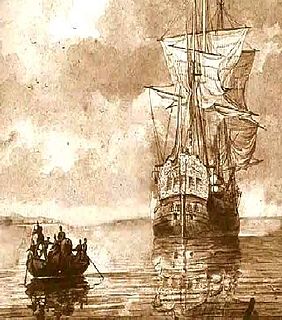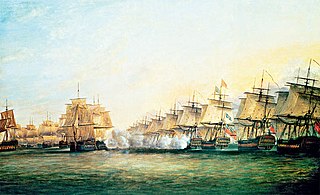
HMS Cornwall was an 80-gun, third rate, ship of the line built for the Royal Navy in the 1690s. She served in the War of the Grand Alliance, and in her first year took part in the Battle of Barfleur and the action at La Hougue.

Oriflamme was a 56-gun ship of the line of the French Navy. She was ordered on 16 February 1743 and built at Toulon Dockyard by engineer-constructor Pierre-Blaise Coulomb, and launched on 30 October 1744. She carried 24 x 18-pounder guns on her lower deck, 26 x 8-pounder guns on her upper deck, and 6 x 4-pounder guns on her quarterdeck. The ship was named for the oriflamme, a long, multi-tailed red banner that was historically the battle standard of the Capetian dynasty.

John Nicholson Inglefield was an English naval officer in the Royal Navy.

HMS Superb was a 74-gun Bellona-class third-rate ship of the line of the Royal Navy, designed by Sir Thomas Slade and built by Adam Hayes at Deptford Dockyard, launched on 27 October 1760 as a sister ship to HMS Dragon.

HMS Boyne was a 98-gun second rate ship of the line of the Royal Navy, built by Nicholas Diddams at Portsmouth Dockyard and launched on 3 July 1810 at Portsmouth. On 12 February 1814 she took part with HMS Caledonia in a hot action against the French line-of-battle ship Romulus off Toulon; the French 74 managed to escape to Toulon by sailing close to the coast to avoid being surrounded. With the 1817 changes to the rating system Boyne was rerated as a 104-gun first rate ship.

The Foudroyant was an 80-gun ship of the line of the French Navy. She was later captured and served in the Royal Navy as the Third Rate HMS Foudroyant.

The Tonnant class was a series of eight 80-gun ships of the line designed in 1787 by Jacques-Noël Sané, whose plans for the prototype were approved on 29 September 1787. With sixteen gunports on the lower deck on each side these were the most effective two-deckers of their era. Their broadside of 1,102 livres equated to 1,190 British pounds weight, over 50% more than the standard British 74-gun ship, and even greater than that of a British 100-gun three-decker.

Téméraire was a 74-gun ship of the line of the French Navy, ordered in December 1747 to a design by François Coulomb, and built at Toulon by his cousin, the constructor Pierre-Blaise Coulomb; she was launched on 24 December 1749. Her 74 guns comprised:
28 x 36-pounders on the lower deck
30 x 18-pounders on the upper deck
10 x 8-pounders on the quarterdeck
6 x 8-pounders on the forecastle.

HMS Modeste was a 64-gun third rate ship of the line of the Royal Navy. She was previously the 64-gun Modeste, of the French Navy, launched in 1759 and captured later that year.

Pégase was a 74-gun ship of the line of the French Navy, lead ship of her class, launched in 1781.
The Centaure class was a class of 74-gun ships of the line of the French Navy, comprising four ships, all of which built at Toulon Dockyard to a design dated 28 March 1782 by Joseph-Marie-Blaise Coulomb in the year following the close of the American Revolutionary War. The first pair were ordered on 15 February 1782, and were named on 13 April. After the first two ships were begun, the design was amended for the second pair – which are accordingly often described as the Séduisant class. This second pair were ordered on 1 June 1782 and named on 21 August. All four ships were destroyed or captured by the British Royal Navy during the French Revolutionary War.

HMS Essex was a 70-gun third rate built by Sir Henry Johnson of Blackwall in 1678/79. During the War of the English Succession she fought in the last major action. She was rebuilt in 1699/1700. During the War of Spanish Succession she fought at Vigo Bay, the Capture of Gibraltar and Velez Malaga. She also fought at the Battle off Passero in 1718. She was rebuilt again in 1736-40. She was in action off Toulon in 1744. She was active in the Channel and against French ports during the Seven Years War. She fought at Quiberon Bay in 1759. She was wrecked in Quiberon Bay in November 1759.
HMS Falmouth was a 50-gun fourth-rate ship of the line built for the Royal Navy in the first decade of the 18th century. The ship participated in several battles during the War of the Spanish Succession (1701–15) and the War of Jenkins' Ear (1739–48).

Terrible was originally a 74-gun ship of the line of the French Navy launched in 1739. Captured on 14 October 1747, she was taken into Royal Navy service as the third rate HMS Terrible.
The Minerve class was a type of 40-gun frigate of the French Navy, carrying 18-pounder long guns as their main armament. Six ships of this type were built at Toulon Dockyard, and launched between 1782 and 1794. The frigates served the French Navy briefly during the French Revolutionary Wars. The Royal Navy captured all six between 1793 and 1799 and took them into service, with all but one serving in the Napoleonic Wars, and some thereafter.

The Pégase class was a class of 74-gun ships of the French Navy, built to a common design by naval constructor Antoine Groignard. It comprised six ships, all ordered during 1781 and all named on 13 July 1781.

HMS Intrepid was a 64-gun third rate ship of the line of the Royal Navy, originally built in Toulon for the French Navy. She was launched in 1740, as Sérieux and fought at the Battle of Toulon before her capture by the British at the First Battle of Cape Finisterre in 1747. After being renamed and refitted by the Royal Navy, she entered British service in late 1747. Between 1748 and 1752 she was assigned as a guard ship off the coast of Kent in south-east England.
The Minotaure was a 74-gun ship of the line of the Royal French Navy, constructed between 1755 and 1757 at the Brest Arsenal in Brest, Brittany.
HMS Sorlings was a 32-gun fifth rate vessel built under contract at Shoreham in 1693/94. After commissioning she spent her time in trade protection services between Home Waters, North America, West Indies and the Mediterranean. She was captured by the French in October 1705. Incorporated into the French Navy, she was loaned to the Privateering squadron at Dunkerque then recaptured by the British in 1711 and sold.
HMS Fowey was a 32-gun fifth rate built by Mr. Flint of Plymouth in 1695/96. She was employed in trade protection and counter-piracy patrols in Home Waters and North America. She was in on the capture of a 50-gun Frenchman while returning from Virginia. She was taken by the French off the Scilly Islands in August 1704.














